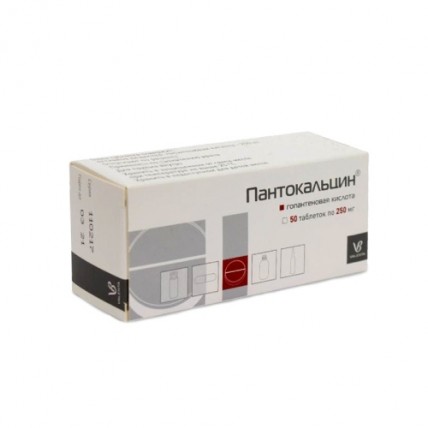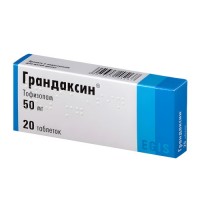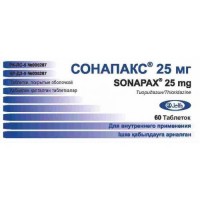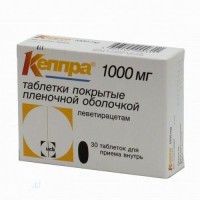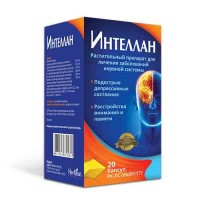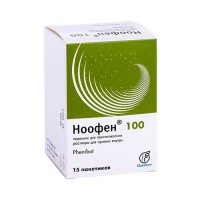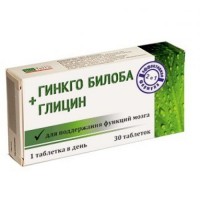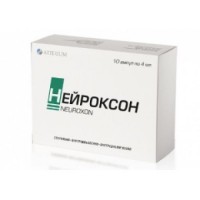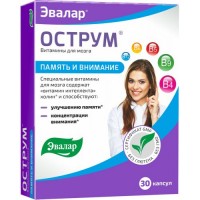Pantocalcin® (Hopantenic Acid) 250 mg, 50 tablets
- $43.00
One tablet contains
Rapidly absorbed from the gastrointestinal tract. The time to reach the maximum concentration in the blood plasma is 1 hour. The highest concentrations are in the liver, kidneys, in the wall of the stomach, and skin. Penetrates through the blood-brain barrier. Not metabolized. It is excreted unchanged within 48 hours (67.5% of the dose taken in the urine, 28.5% in the feces).
The spectrum of action is associated with the presence of gamma-aminobutyric acid in the structure.
The mechanism of action is due to the direct effect of pantocalcin on the GABAB receptor-channel complex. It has neurometabolic, neuroprotective and neurotrophic properties. Increases the resistance of the brain to hypoxia and the effects of toxic substances, stimulates anabolic processes in neurons. It has an anticonvulsant effect, reduces motor excitability while streamlining behavior. Increases mental and physical performance. Contributes to the normalization of the content of gamma-aminobutyric acid in chronic alcohol intoxication and subsequent withdrawal of ethanol. Shows analgesic action. It is able to inhibit acetylation reactions involved in the mechanisms of inactivation of novocaine and sulfonamides, thereby prolonging the action of the latter is achieved. Causes inhibition of pathologically increased cystic reflex and detrusor tone.
– cognitive impairments in organic brain lesions and neurotic disorders
- as part of the complex therapy of cerebrovascular insufficiency caused by atherosclerotic changes in cerebral vessels, senile dementia (initial form), residual organic brain lesions in adults and the elderly
- cerebral organic insufficiency in patients with schizophrenia (in combination with neuroleptics, antidepressants)
- extrapyramidal hyperkinesis in patients with hereditary diseases of the nervous system (Huntington's chorea, hepatocerebral dystrophy, Parkinson's disease, etc.)
– consequences of previous neuroinfections and craniocerebral injuries (as part of complex therapy)
- to correct the side effects of neuroleptics and for prophylactic purposes simultaneously as a "cover therapy", extrapyramidal neuroleptic syndrome (hyperkinetic and akinetic)
- epilepsy with mental retardation (in combination with anticonvulsants)
– psycho-emotional overload, decrease in mental and physical performance, to improve concentration and memorization
– neurogenic urinary disorders: enuresis, daytime urinary incontinence, pollakiuria, urgency
- children with mental retardation (retardation of mental, speech, motor development or their combination), cerebral palsy, stuttering (mainly clonic form), epilepsy (as part of combination therapy with anticonvulsants, especially with polymorphic seizures and minor epileptic seizures)
Inside, 15-30 minutes after eating.
A single dose for adults is 0.5-1 g, for children - 0.25-0.5 g; daily dose for adults - 1.5-3 g, for children - 0.75-3 g.
The duration of the course of treatment is from 1 to 4 months, in some cases - up to 6 months.
After 3-6 months, a second course of treatment is possible.
Children with mental retardation:
0.5 g 4-6 times a day for 3 months;
with a delay in speech development, 0.5 g 3-4 times a day for 2-3 months.
In case of neuroleptic syndrome (as a corrector of side effects of antipsychotic drugs): adults - 0.5-1 g 3 times a day, children - 0.25-0.5 g 3-4 times a day. The duration of the course of treatment is 1-3 months.
With epilepsy: children 0.25-0.5 g 3-4 times a day,
adults 0.5 g up to 4 times a day or 1 g up to 3 times a day daily for a long time (up to 6 months).
With hyperkinesis (tics): children 0.25-0.5 g 3-6 times a day for 1-4 months, adults 1.5-3 g a day daily for 1-5 months.
For urination disorders: adults 0.5-1 g 2-3 times a day (daily dose 2-3 g), children 0.25-0.5 g (daily dose 25-50 mg / kg). The duration of the course of treatment is from 2 weeks to 3 months (depending on the severity of the disorders and the therapeutic effect).
With the consequences of neuroinfection and traumatic brain injury: 0.25 g 3-4 times a day.
To restore working capacity at increased loads and asthenic conditions: 0.25 g 3 times a day.
For children, the dosage and treatment regimen are prescribed by the doctor individually (depending on the clinical indications).
– allergic reactions are possible: rhinitis, conjunctivitis, skin rashes
Very rarely - sleep disturbances, drowsiness, noise in the head
There is evidence that taking hopantenic acid in some cases can cause acute fatal hepatic encephalopathy due to a deficiency of pantothenic acid, the antagonist of which is hopantenic acid.
- hypersensitivity to any component of the drug
- acute renal failure, acute severe kidney disease
- pronounced changes in peripheral blood parameters
- pregnancy and lactation
- children's age up to 6 years (for this dosage form)
Prolongs the action of barbiturates; enhances the effect of drugs that stimulate the central nervous system, anticonvulsant drugs, the effect of local anesthetics (procaine). Prevents side effects of phenobarbital, carbamazepine, antipsychotics (neuroleptics).
The action of hopantenic acid is enhanced in combination with glycine, ksidifon.
Potentiates the action of local anesthetics (novocaine).
In conditions of long-term treatment, simultaneous administration with other nootropic and central nervous system stimulating drugs is not recommended.
Use during pregnancy and lactation
Experimental studies have shown that hopantenic acid does not have a teratogenic and embryotoxic effect. There are no clinical data on the use of hopantenic acid during pregnancy, so the use of the drug during pregnancy is contraindicated.
Studies in women during breastfeeding have not been conducted, therefore, if necessary, the use of the drug during lactation should stop breastfeeding.
Features of the effect of the drug on the ability to drive a vehicle or potentially dangerous mechanisms
Care should be taken when driving vehicles or other potentially dangerous mechanisms at the beginning of therapy due to possible transient side effects (drowsiness, noise in the head).
Symptoms: increased side effects.
Treatment: activated charcoal, gastric lavage, symptomatic therapy
Store in a dry, dark place at a temperature not exceeding 25ºC.
Keep out of the reach of children!
Shelf life - 4 years
Do not use after the expiration date.
- Active ingredients: Hopantenic acid (hopantenic acid or calcium salt of hopantenic acid) - 250 mg,
- Excipients: basic magnesium hydroxycarbonate, calcium stearate, talc, potato starch
Pharmacological properties
Pharmacokinetics
Rapidly absorbed from the gastrointestinal tract. The time to reach the maximum concentration in the blood plasma is 1 hour. The highest concentrations are in the liver, kidneys, in the wall of the stomach, and skin. Penetrates through the blood-brain barrier. Not metabolized. It is excreted unchanged within 48 hours (67.5% of the dose taken in the urine, 28.5% in the feces).
Pharmacodynamics
The spectrum of action is associated with the presence of gamma-aminobutyric acid in the structure.
The mechanism of action is due to the direct effect of pantocalcin on the GABAB receptor-channel complex. It has neurometabolic, neuroprotective and neurotrophic properties. Increases the resistance of the brain to hypoxia and the effects of toxic substances, stimulates anabolic processes in neurons. It has an anticonvulsant effect, reduces motor excitability while streamlining behavior. Increases mental and physical performance. Contributes to the normalization of the content of gamma-aminobutyric acid in chronic alcohol intoxication and subsequent withdrawal of ethanol. Shows analgesic action. It is able to inhibit acetylation reactions involved in the mechanisms of inactivation of novocaine and sulfonamides, thereby prolonging the action of the latter is achieved. Causes inhibition of pathologically increased cystic reflex and detrusor tone.
Indications for use
– cognitive impairments in organic brain lesions and neurotic disorders
- as part of the complex therapy of cerebrovascular insufficiency caused by atherosclerotic changes in cerebral vessels, senile dementia (initial form), residual organic brain lesions in adults and the elderly
- cerebral organic insufficiency in patients with schizophrenia (in combination with neuroleptics, antidepressants)
- extrapyramidal hyperkinesis in patients with hereditary diseases of the nervous system (Huntington's chorea, hepatocerebral dystrophy, Parkinson's disease, etc.)
– consequences of previous neuroinfections and craniocerebral injuries (as part of complex therapy)
- to correct the side effects of neuroleptics and for prophylactic purposes simultaneously as a "cover therapy", extrapyramidal neuroleptic syndrome (hyperkinetic and akinetic)
- epilepsy with mental retardation (in combination with anticonvulsants)
– psycho-emotional overload, decrease in mental and physical performance, to improve concentration and memorization
– neurogenic urinary disorders: enuresis, daytime urinary incontinence, pollakiuria, urgency
- children with mental retardation (retardation of mental, speech, motor development or their combination), cerebral palsy, stuttering (mainly clonic form), epilepsy (as part of combination therapy with anticonvulsants, especially with polymorphic seizures and minor epileptic seizures)
Dosage and administration
Inside, 15-30 minutes after eating.
A single dose for adults is 0.5-1 g, for children - 0.25-0.5 g; daily dose for adults - 1.5-3 g, for children - 0.75-3 g.
The duration of the course of treatment is from 1 to 4 months, in some cases - up to 6 months.
After 3-6 months, a second course of treatment is possible.
Children with mental retardation:
0.5 g 4-6 times a day for 3 months;
with a delay in speech development, 0.5 g 3-4 times a day for 2-3 months.
In case of neuroleptic syndrome (as a corrector of side effects of antipsychotic drugs): adults - 0.5-1 g 3 times a day, children - 0.25-0.5 g 3-4 times a day. The duration of the course of treatment is 1-3 months.
With epilepsy: children 0.25-0.5 g 3-4 times a day,
adults 0.5 g up to 4 times a day or 1 g up to 3 times a day daily for a long time (up to 6 months).
With hyperkinesis (tics): children 0.25-0.5 g 3-6 times a day for 1-4 months, adults 1.5-3 g a day daily for 1-5 months.
For urination disorders: adults 0.5-1 g 2-3 times a day (daily dose 2-3 g), children 0.25-0.5 g (daily dose 25-50 mg / kg). The duration of the course of treatment is from 2 weeks to 3 months (depending on the severity of the disorders and the therapeutic effect).
With the consequences of neuroinfection and traumatic brain injury: 0.25 g 3-4 times a day.
To restore working capacity at increased loads and asthenic conditions: 0.25 g 3 times a day.
For children, the dosage and treatment regimen are prescribed by the doctor individually (depending on the clinical indications).
Possible side effects
– allergic reactions are possible: rhinitis, conjunctivitis, skin rashes
Very rarely - sleep disturbances, drowsiness, noise in the head
There is evidence that taking hopantenic acid in some cases can cause acute fatal hepatic encephalopathy due to a deficiency of pantothenic acid, the antagonist of which is hopantenic acid.
Contraindications
- hypersensitivity to any component of the drug
- acute renal failure, acute severe kidney disease
- pronounced changes in peripheral blood parameters
- pregnancy and lactation
- children's age up to 6 years (for this dosage form)
Drug Interactions
Prolongs the action of barbiturates; enhances the effect of drugs that stimulate the central nervous system, anticonvulsant drugs, the effect of local anesthetics (procaine). Prevents side effects of phenobarbital, carbamazepine, antipsychotics (neuroleptics).
The action of hopantenic acid is enhanced in combination with glycine, ksidifon.
Potentiates the action of local anesthetics (novocaine).
Special instructions
In conditions of long-term treatment, simultaneous administration with other nootropic and central nervous system stimulating drugs is not recommended.
Use during pregnancy and lactation
Experimental studies have shown that hopantenic acid does not have a teratogenic and embryotoxic effect. There are no clinical data on the use of hopantenic acid during pregnancy, so the use of the drug during pregnancy is contraindicated.
Studies in women during breastfeeding have not been conducted, therefore, if necessary, the use of the drug during lactation should stop breastfeeding.
Features of the effect of the drug on the ability to drive a vehicle or potentially dangerous mechanisms
Care should be taken when driving vehicles or other potentially dangerous mechanisms at the beginning of therapy due to possible transient side effects (drowsiness, noise in the head).
Overdose
Symptoms: increased side effects.
Treatment: activated charcoal, gastric lavage, symptomatic therapy
Storage conditions
Store in a dry, dark place at a temperature not exceeding 25ºC.
Keep out of the reach of children!
Shelf life - 4 years
Do not use after the expiration date.
